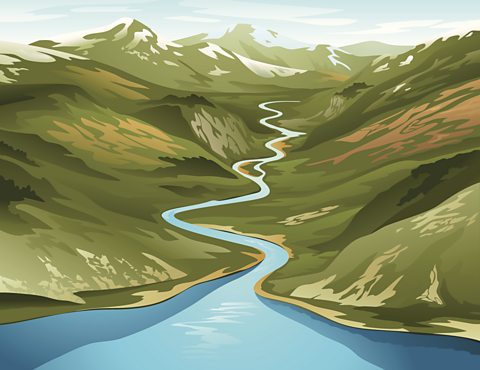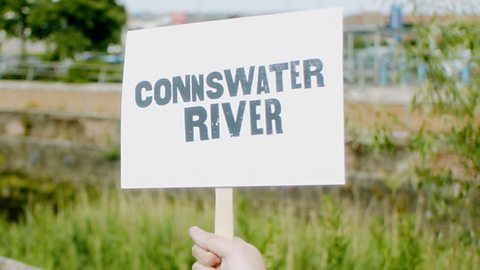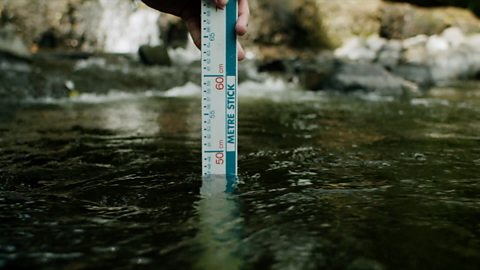As rivers flow towards the sea, they change the landscape they pass through. These processes are known as erosion, transportation and deposition.
River course

A river is divided up into three sections called courses. There is the upper, middle and a lower course.
A river starts in the upper course, usually an elevated section of land such as a mountain area. The reason why rivers start here is because mountains receive the highest amounts of rainfall. At the point where the river starts, we call this the source.
But how does the water get there to begin with? The Earth has a natural water cycle to take care of this.

The water cycle
There are seven stages to this cycle: evaporation, transpiration, condensation, precipitation, surface run-off, groundwater flow and drainage basin.
- Evaporation is when the sun heats up water from the sea, transforms into a gas and goes into the air.
- Transpiration occurs when the sun heats up water from the leaves of trees and then follows the same process as evaporation.
- Condensation happens when water vapour, which is the gaseous phase of water, cools and turns into clouds.
- Precipitation can be rain, hail, sleet and snow ÔÇö in fact anything that can easily transform into liquid again and fall from the clouds.
- Surface run-off occurs when the water runs off the surface of the ground.
- Groundwater flow involves how the water goes into the ground via the process of infiltration and moves slowly back through the rocks and soil underground.
- The water then drains into a specific river from the area of land, called the drainage basin. From there, it flows down a river into the mouth, the point where the river meets the sea or ocean, back into the sea and the cycle repeats.
Erosion
As a river travels downstream, it erodes the landscape. Erosion is when land is worn away by another material. It's a natural process that's been going on for millions of years and it continues to shape our planet's landscape today. Water is a very powerful force when you come to think of it. Although seemingly harmless, it wears away the landscape and sculpts some of the most beautiful spots around us.
There are four main types of water erosion:
- Hydraulic action refers to the force of water that hits against the river bed and removes material. It tends to be quick, high-energy water.
- Abrasion occurs when sediment carried by the water hits the river channel and removes material in a sandpapering effect.
- Attrition happens when stones carried by the water hit into each other, gradually making the rocks smaller and smoother.
- The final main type of water erosion is solution, when soluble materials dissolve in the water and are carried along.
The rate of erosion depends upon the force of the water and the durability of the material thatÔÇÖs being worn away. For example, limestone dissolves quicker in a fast-running river than a light drizzle in someoneÔÇÖs backyard and it dissolves at a faster rate than basalt because it is less durable. In rivers, faster currents will erode the riverbank and riverbed at a faster rate as the water moves along compared to small streams. However, thatÔÇÖs not to say that the gentle, slow flow of a stream will not have an impact over time.
River erosion caused by fast currents often creates a V-shaped valley. The river channel is where a river flows. Other streams and rivers will join it and it will become deeper and wider. Inevitably, a river will reach a large body of water, such as a sea, ocean or lake, that point of entry is called the mouth of the river.
Similar to erosion, weathering can also cause the breaking down of materials in the atmosphere. There are three main types of weathering: chemical, physical and biological.
- Chemical weathering occurs when chemicals in the rain dissolve the rock.
- Physical weathering is when a temperature change affects the rock and causes it to break open.
- Biological weathering happens when plants and animals weaken the structure of the rock until it breaks away.
Transportation and deposition
As the river flows through its courses, it picks up the small bits of the eroded rock and carries them downstream in different ways. The small bits of eroded rock are called sediment and the process of it being carried by the river downstream is called transportation.
There are four different types of transportation: Traction, Saltation, Suspension and Solution.
- Traction is the process of large, heavy rock particles rolling along the bottom of the river. This process is most common near the source of a river, because the bedload is at its biggest.
- Saltation involves pebble-sized particles bouncing along the riverbed, which also most commonly happens near the source.
- Suspension refers to how small particles, such as silt and clay, are carried in the water. Such lighter particles are suspended (carried) near the mouth of the river.
- Solution occurs when soluble materials dissolve in the water and are carried along. The transport of these dissolved chemicals varies along the river.
Deposition occurs in places where the water does not have enough energy to carry its rock load and as a result it is dropped. As we will see with the Curly Burn river, slower areas of the river, especially when it meanders and turns, can create a slip-off slope on one side of the channel because all the energy is directed on the other side. At such points along the river, the lack of energy will deposit an uneven slope, thereby creating an uneven, unbalanced shape of the riverbed.
The Curly Burn runs between Coleraine and Limavady in the North West of Northern Ireland. It is an 11 kilometre stretch of water and is easily accessible through many sites. The source of the Curly Burn can be located on Binevanagh Mountain, which has panoramic views over Lough Foyle, the Roe Valley, Inishowen and, on a clear day, to the west coast of Scotland. It is a perfect place to conduct fieldwork or look closely at how rivers function in this part of the world.
Test yourself
More on Rivers and Water
Find out more by working through a topic
- count3 of 4

- count4 of 4

- count1 of 4
